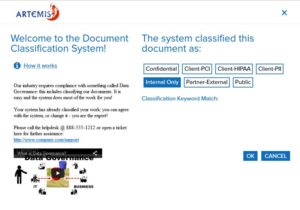The Requirement for Classification as part of GDPR Compliance
Data privacy in the scope of the GDPR requires a clear understanding of the data you retain. What type of data is being stored, where it is being stored, and who is accessing it are the guiding principles, and classification of this data is your key to success and peace of mind.
Data classification is critical to ensuring that you can identify unusual access patterns before they become an issue. Classification will give you deeper insights into where the data is being stored, and it will also provide full control and governance over each individual file. The latter is extremely important in light of the “right to be forgotten” rule, which allows your online customers to request that their file and all its associated information be removed from your system.
In the years since the GDPR deadline was announced, many companies and IT admins have struggled to find a workflow that would make the governance of these individual data sets accessible without compromising other areas. To enable these tasks, a data classification solution was necessary in order to:
- Quickly sort and classify all retained customer data
- Do so without adding to or complicating the IT workload
- Provide an easily deployable platform that works with any operating system
- Protect each dataset appropriately according to its classification
- Enable easy access to specific classifications of data for removal purposes
Data classification is nothing new
While all the recent talk about data classification may have you thinking that this is an entirely new problem, its roots go back to the Official Secrets Act of 1889. This treatise was enacted to prevent the disclosure of official documents and information, mostly for governmental or financial reasons.

Despite the fact that the concept and practice have been around for more than a century, it has not been widely adopted outside of public governance and those that do practice it often don’t do it very well. However, there are plenty of reasons to adopt it now – the GDPR being a primary motivation – and the benefits to your company’s management as well as its IT activities are many.
Additionally, as data is increasingly stored in multiple locations and silos (think Excel spreadsheets AND databases, or PDFs from the Fax machine and order entry systems) – the ability to discover and classify datasets in hundreds of data types is increasingly seen as a default requirement.
For instance, it is estimated that 85% or more of a company’s stored data is either redundant, obsolete or trivial, meaning there is no practical need for you to store it at all. Removing this data has several advantages:
- It will free up storage space and could help your IT systems to run more efficiently
- It will give you a more accurate snapshot of the viable data you are storing
- It may lead to more efficient indexing
- It will allow for faster access and recovery times
But most of all, it will reduce your risk, and that is the main concern with the GDPR, as the fines for breaches and non-compliance are significant and could put your business continuity in peril.
If you are looking for ways to streamline your data classification process in light of the GDPR, discover specific items in your structured and unstructured datasets, ask us to download a free trial of ClassiDocs Data Classification, Discovery and Governance platform today.
